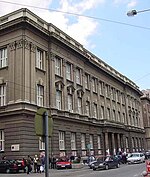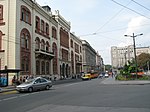Bombing of Belgrade (1944)

The Allies carried out an aerial bombing campaign against the Axis in Belgrade during the Allied bombing of Yugoslavia in World War II. The air strikes lasted from 16 April 1944 to 6 September 1944. Belgrade was bombed eleven times by the Anglo–American air force. Infrastructure in Belgrade was bombed three times in April, twice in May, once in June and July and four times in September 1944. The heaviest casualties were recorded during the April bombing on 16 April and 17 April 1944, which coincided with the first and second days of Orthodox Easter that year. The main unit in this action was the American Fifteenth Air Force, with a base in Foggia in the south of Italy. 600 bombers took part, dropping carpet bombs from 3,000 – 5,000 metres. There was no anti-aircraft defense. Several people died on 16 April. The population of Belgrade at the time believed that the bombing was an introduction to an Allied military invasion. The bombing continued with greater intensity on 17 April, when the Sajmište concentration camp was hit where 60 detainees were killed and about 150 wounded in the camp. Belgrade was bombed again by the Allies on 21 April, 24 April, 18 May, 6 June, 8 July, and 6 September 1944.
Excerpt from the Wikipedia article Bombing of Belgrade (1944) (License: CC BY-SA 3.0, Authors, Images).Bombing of Belgrade (1944)
Belgrade Old Town (Stari Grad Urban Municipality)
Geographical coordinates (GPS) Address Nearby Places Show on map
Geographical coordinates (GPS)
| Latitude | Longitude |
|---|---|
| N 44.817777777778 ° | E 20.456944444444 ° |
Address
11000 Belgrade, Old Town (Stari Grad Urban Municipality)
Central Serbia, Serbia
Open on Google Maps










